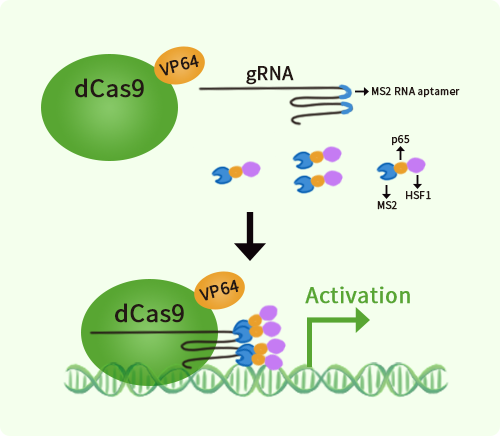Human NKG2D (KLRK1) activation kit by CRISPRa
CAT#: GA107907
KLRK1 CRISPRa kit - CRISPR gene activation of human killer cell lectin like receptor K1
Find the corresponding CRISPRi Inhibitor Kit
USD 1,290.00
2 Weeks*
Specifications
| Product Data | |
| Format | 3gRNAs, 1 scramble ctrl and 1 enhancer vector |
| Symbol | KLRK1 |
| Locus ID | 22914 |
| Kit Components | GA107907G1, KLRK1 gRNA vector 1 in pCas-Guide-CRISPRa GA107907G2, KLRK1 gRNA vector 2 in pCas-Guide-CRISPRa GA107907G3, KLRK1 gRNA vector 3 in pCas-Guide-CRISPRa 1 CRISPRa-Enhancer vector, SKU GE100056 1 CRISPRa scramble vector, SKU GE100058 |
| Disclaimer | The kit is designed based on the best knowledge of CRISPa SAM technology. The efficiency of the activation can be affected by many factors, including nucleosome occupancy status, chromatin structure and the gene expression level of the target, etc. |
| Reference Data | |
| RefSeq | NM_007360 |
| Synonyms | CD314; D12S2489E; KLR; NKG2-D; NKG2D |
| Summary | Natural killer (NK) cells are lymphocytes that can mediate lysis of certain tumor cells and virus-infected cells without previous activation. They can also regulate specific humoral and cell-mediated immunity. NK cells preferentially express several calcium-dependent (C-type) lectins, which have been implicated in the regulation of NK cell function. The NKG2 gene family is located within the NK complex, a region that contains several C-type lectin genes preferentially expressed in NK cells. This gene encodes a member of the NKG2 family. The encoded transmembrane protein is characterized by a type II membrane orientation (has an extracellular C terminus) and the presence of a C-type lectin domain. It binds to a diverse family of ligands that include MHC class I chain-related A and B proteins and UL-16 binding proteins, where ligand-receptor interactions can result in the activation of NK and T cells. The surface expression of these ligands is important for the recognition of stressed cells by the immune system, and thus this protein and its ligands are therapeutic targets for the treatment of immune diseases and cancers. Read-through transcription exists between this gene and the upstream KLRC4 (killer cell lectin-like receptor subfamily C, member 4) family member in the same cluster. [provided by RefSeq, Dec 2010] |
Documents
| Product Manuals |
| FAQs |
| SDS |
Resources
Other Versions
| SKU | Description | Size | Price |
|---|---|---|---|
| KN208050 | KLRK1 - human gene knockout kit via CRISPR, HDR mediated |
USD 1,290.00 |
|
| KN208050BN | KLRK1 - human gene knockout kit via CRISPR, HDR mediated |
USD 1,290.00 |
|
| KN208050LP | KLRK1 - human gene knockout kit via CRISPR, HDR mediated |
USD 1,290.00 |
|
| KN208050RB | KLRK1 - human gene knockout kit via CRISPR, HDR mediated |
USD 1,290.00 |
|
| KN408050 | KLRK1 - KN2.0, Human gene knockout kit via CRISPR, non-homology mediated. |
USD 1,290.00 |
{0} Product Review(s)
Be the first one to submit a review






























































































































































































































































 Germany
Germany
 Japan
Japan
 United Kingdom
United Kingdom
 China
China
